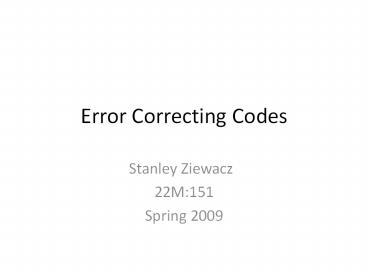Error Correcting Codes - PowerPoint PPT Presentation
Title:
Error Correcting Codes
Description:
... 1012, 1020, 1201, 2021, 2102, 2210} ternary code of length 4 ... (4, 9, 3) ternary code. constructed from orthogonal Latin squares. 0 0 0 0. 0 1 1 1. 0 2 2 2 ... – PowerPoint PPT presentation
Number of Views:267
Avg rating:3.0/5.0
Title: Error Correcting Codes
1
Error Correcting Codes
- Stanley Ziewacz
- 22M151
- Spring 2009
2
Information Transmission
Transmission
3
Information Transmission
Transmission
Error!
4
Information Transmissionwith Parity Bit
Transmission
5
Information Transmissionwith Parity Bit
Transmission
Error Detected
6
Definition of Code
Block code all words are the same length. A
q-ary code C of length n is a set of n-character
words over an alphabet of q elements.
Examples C1 000, 111 binary code of length
3 C2 00000, 01100, 10110 binary code of
length 5 C3 0000, 0111, 0222, 1012, 1020,
1201, 2021, 2102, 2210 ternary code of length 4
7
Error Correcting Code
- An error is a change in a symbol
- Want to detect and correct up to t errors in a
code word - Basic assumptions
- If i lt j then i errors are more likely than j
errors - Errors occur randomly
- Nearest neighbor decoding
- Decode y to c, where c has fewer differences from
y than any other codeword
8
Hamming Distance
- The Hamming distance between two words over the
same alphabet is the number of places where the
symbols differ. - Example d(100111, 001110) 3
- Look at 100111
- 001110
- For a code , C, the minimum distance d(C) is
defined by d(C) mind(c1,c2), c1, c2?C, c1?c2
9
Hamming Distance Properties
- Let x and y be any words over the alphabet for
C x and y may or not be codewords. - d(x, y) 0 iff x y
- d(x, y) d(y, x) for all x, y
- d(x, y) ? d(x, z) d(z, y) for all x, y, and z
10
Detection and Correction
- A code C can detect up to s errors in any
codeword if d (C) ? s 1 - A code C can correct up to t errors if d(C) ? 2t
1 - Suppose c is sent and y is received, d(c,y) ?
tand (c ? c) - Use triangle inequality2t 1 ? d(c, c) ? d(c,
y) d(y, c) ? t d(y,c)
11
(n, M, d) q-ary code C
- Codewords are n characters long
- d(C) d
- M codewords
- q characters in alphabet
- Want n as small as possible with d and M as large
as possible - These are contradictory goals
12
Hard Problem
- Maximize the number of codewords in a q-ary code
with given length n and given minimum distance d. - Well use Latin squares to construct some codes.
13
(4, 9, 3) ternary code
- 0 0 0 0
- 0 1 1 1
- 0 2 2 2
- 1 0 1 2
- 1 1 2 0
- 1 2 0 1
- 2 0 2 1
- 2 1 0 2
- 2 2 1 0
14
Latin square
- A Latin square of order n is an n x n array in
which n distinct symbols are arranged so that
each symbol occurs once in each row and column. - Examples
- 0 1 2 0 1 2
- 1 2 0 2 0 1
- 2 0 1 1 2 0
15
Orthogonal Latin Squares
- Two distinct Latin squares A (aij) and B (bij)
are orthogonal if the n x n ordered pairs(aij,
bij) are all distinct. - Example
- 0 1 2 0 1 2 (0,0) (1,1) (2,2)
- A 1 2 0 B 2 0 1 (1,2) (2,0) (0,1)
- 2 0 1 1 2 0 (2,1) (0,2) (1,0)
16
(4, 9, 3) ternary codeconstructed from
orthogonal Latin squares
0 0 0 0 0 1 1 1 0 2 2 2 1 0 1 2 1 1 2
0 1 2 0 1 2 0 2 1 2 1 0 2 2 2 1 0
0 1 2 0 1 2 1 2 0 2 0 1 2 0 1 1 2 0
17
Theorem
- There exists a q-ary (4, q2, 3) code iff there
exists a pair of orthogonal Latin squares of
order q. - Proof
- Look at the following 6 sets
- (i, j) (i, aij), (i, bij), (j, aij),
(j, bij), (aij, bij)
18
References
- Colbourn, Charles J. and Jeffrey H. Dinitz,
Handbook of Combinatorial Designs, Second
Edition, Chapman Hall/CRC, Boca Raton, FL, 2007
- Laywine, Charles F. and Gary L. Mullen, Discrete
Mathematics Using Latin Squares, John Wiley and
Sons, New York, 1998 - Pless, Vera, Introduction to the Theory of
Error-Correcting Codes, John Wiley and Sons, New
York, 1982 - Roberts, Fred S. and Barry Tesman, Applied
Combinatorics, 2nd Edition, Pearson Education,
Upper Saddle River, NJ , 2005
19
(No Transcript)































